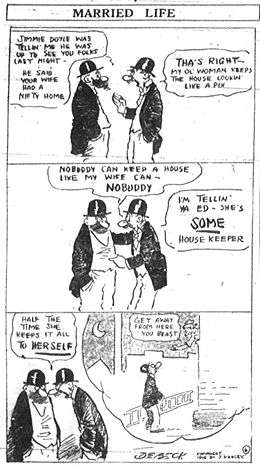Visual literacy
Visual literacy is the ability to interpret, negotiate, and make meaning from information presented in the form of an image, extending the meaning of literacy, which commonly signifies interpretation of a written or printed text. Visual literacy is based on the idea that pictures can be “read” and that meaning can be through a process of reading.
Background
 | |
|
|
The notion of visual literacy has been transforming the age of digital learning and reflecting the transformation of datagogies for quite some time. Classical and Medieval theories of memory and learning, for instance, placed a strong emphases on how the visual format of words and lines affected the ordering of information in the mind. During the Enlightenment new emphasis was placed on training the senses through print and graphic technologies in a way that benefitted the rising middle class.[1][2] By the nineteenth century visual literacy was a core component of the national educations systems that were emerging in Europe and North America, with educational reformers like Sir John Lubbock arguing for visual tools like diagrams and models to be used in the classroom.
The term "visual literacy" is credited to John Debes, co-founder of the International Visual Literacy Association.[3] In 1969 Debes offered a tentative definition of the concept: "Visual literacy refers to a group of vision-competencies a human being can develop by seeing and at the same time having and integrating other sensory experiences."[4] A white paper drawn up in January 2004, defines visual literacy as "understanding how people perceive objects, interpret what they see, and what they learn from them."[5] However, because multiple disciplines such as visual literacy in education, art history and criticism, rhetoric, semiotics, philosophy, information design, and graphic design make use of the term visual literacy, arriving at a common definition of visual literacy has been contested since its first appearance in professional publications.

Since technological advances continue to develop at an unprecedented rate, educators are increasingly promoting the learning of visual literacies as indispensable to life in the information age. Similar to linguistic literacy (meaning-making derived from written or oral human language) commonly taught in schools, most educators would agree that literacy in the 21st Century has a wider scope.[6] Educators are recognizing the importance of helping students develop visual literacies in order to survive and communicate in a highly complex world.
Many scholars from the New London Group[7] such as Courtney Cazden, James Gee, Gunther Kress, and Allan Luke advocate against the dichotomy of visual literacy versus linguistic literacy. Instead, they stress the necessity of accepting the co-presence[8] of linguistic literacies and visual literacies as interacting and interlacing modalities which complement one another in the meaning making process.

Visual literacy is not limited to modern mass media and new technologies. The graphic novel Understanding Comics by Scott McCloud discusses the history of narrative in visual media. Also, animal drawings in ancient caves, such as the one in Lascaux, France, are early forms of visual literacy. Hence, even though the name visual literacy itself as a label dates to the 1960s, the concept of reading signs and symbols is prehistoric.
Visual literacy is the ability to evaluate, apply, or create conceptual visual representations. Skills include the evaluation of advantages and disadvantages of visual representations, to improve shortcomings, to use them to create and communicate knowledge, or to devise new ways of representing insights. The didactic approach consists of rooting visualization in its application contexts, i.e. giving the necessary critical attitude, principles, tools and feedback to develop their own high-quality visualization formats for specific problems (problem-based learning). The commonalities of good visualization in diverse areas, and exploration of the specificities of visualization in the field of specialization (through real-life case studies).

Visual Literacy Standards for teaching in higher education were adopted by the Association of College & Research Libraries in 2011.[9] They were "developed over a period of 19 months, informed by current literature, shaped by input from multiple communities and organizations, reviewed by individuals from over 50 institutions, and approved by 3 ACRL committees and the ACRL Board of Directors."[10]
Education
There are many different formats of visual literacy and also many different ways of teaching students how to interpret visual literacy. Questions to be asked when looking at visuals can be "What is going on in this photograph?" and "What comes to mind when you first look at this photograph?". This allows students to begin the analyzing process. When looking at visuals, students should be able to see, understand, think, create and communicate graphically. In order to do all, the student must always carefully observe.
Martin Scorsese, director and filmmaker, emphasizes how children should begin developing visual literacy skills at an early age. This involves exploring how ideas and emotions are expressed and the use of lighting to create a emotional or physiological point. He explains how there is a need for children to understand these concepts. Visual literacy is taught in many schools and is becoming a more popular subject throughout the years. With technology, images and visual presentations are flourishing more than ever.
See also
Endnotes
- ↑ Eddy, Matthew Daniel (2013). "The Shape of Knowledge: Children and the Visual Culture of Literacy and Numeracy". Science in Context. 26: 215–245. doi:10.1017/s0269889713000045.
- ↑ Eddy, Mathew Daniel (2016). "The Child Writer: Graphic Literacy and the Scottish Educational System, 1700–1820". History of Education. 45: 695–718.
- ↑ What is visual literacy?, International Visual Literacy Association
- ↑ Avgerinou, M. & Ericson, J. (1997). "A review of the concept of visual literacy", British Journal of Educational Technology, 28(4), 280-291.
- ↑ Elkins, James 2010. The concept of visual literacy, and its limitations, In: Visual Literacy, ed. James Elkins. Routledge, New York. pgs 217.
- ↑ Riddle, J. (2009). Engaging the Eye Generation: Visual Literacy Strategies for the K-5 Classroom. Stenhouse Publishers page 3. ISBN 978-1-57110-749-7
- ↑ The New London School, Information Habitat wiki, Michigan State University
- ↑ Kress, Gunther R. (2003). Literacy in the New Media Age. New York: Routledge. ISBN 0-415-25356-X.
- ↑ ACRL Visual Literacy Competency Standards for Higher Education
- ↑ http://acrlvislitstandards.wordpress.com/
External links

- A workshop on visualization literacy @ IEEE VIS 2014 with some relevant resources
- Visual Literacy Resources via the Toledo Museum of Art
- Journal of Visual Literacy, International Visual Literacy Association
- Learning Resources on Visual Literacy for Management, Communication and Engineering
- Visual Literacy from 21st Century Literacies, AT&T Knowledge Network Explorer
- Joel & Irene Benedict Visual Literacy Collection, Arizona State University
- viz.: Rhetoric, Visual Culture, Pedagogy, University of Texas at Austin
- International Visual Sociology Association (IVSA)
- Visual Literacy & The Expansion Of Creativity (IC)
- Visual Literacy and Learning in Science - from the Education Resources Information Center Clearinghouse for Science, Mathematics, and Environmental Education
- Visual Literacy, Knowledge Quest, Volume 36, Number 3 (January/February 2008)
- Visual Literacy at University Museums, University Museums, Iowa State University